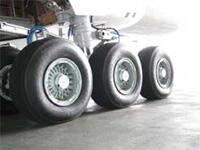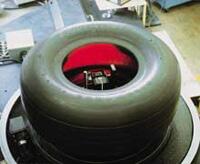- Home
- Products
- Aircraft Tires
- R&D
- Design
R&D
- Bias Tire Technology
- ACOT
- Radial Tire Development
- Revolutionarily Reinforced Radial Tire
- Tire Development and Testing
- Retreading Technology
- Shearographic Inspection
Bias Tire Technology
Among the center's most renowned achievements to date is the development of the Tension Control Optimization Theory (TCOT), a new theory of tire design which allows for the simultaneous improvement of several previously incompatible tire performance characteristics in radial truck and bus tires. Highly successful, this theory influenced the development of ACOT, or Aircraft Tire Tension Control Optimization Theory.
Incorporated into Bridgestone aircraft bias tires, this new theory created a technological revolution in tire design by providing greater overload durability and allowing for greater weight reduction.
ACOT
What would happen, if when designing a bias aircraft tire, one were to move away from the conventional “Natural Equilibrium Shape Theory?” Bridgestone engineers took this question to task, and when the results were in, they discovered that they had created a revolution in tire design.
It was discovered that by changing the shape of the case line, away from the "natural shape," carcass cord tension could be controlled and the tire durability greatly enhanced. The compression of carcass cords is the greatest detrimental factor to overload durability as nylon cord is resilient to tension but weak against compression. By increasing carcass tension in the tire's vulnerable areas, compression is reduced, thereby increasing overload durability performance. This translates into greater safety during long taxi and high speed taxi situations as well as improved performance for double load taxi and takeoff.
ACOT technology creates the possibility to reduce tire weights without sacrificing overload durability, and has given Bridgestone the flexibility to design products which best meet individual aircraft needs, maximizing weight reduction and overload performance to provide the best possible tire. This technology has been incorporated into the Improved Bias tire (IBT) which is approximately seven percent lighter that conventional tires, and the Performance Weight Optimized Tire (PWO) which also uses new cord technology to achieve further weight reduction.
Radial Tire Development

After years of experience working with bias tire technology, Bridgestone engineers have applied their expertise in new areas and have successfully developed high performance radial tires. In service, these radial tires have seen outstanding results, enabling Bridgestone to supply radial tires for many new generation aircrafts. Currently available for the Boeing B777, B747-400ER, B767-400ER MLG tire, B737 NLG tire, the Airbus A320 family, and A330/A340 operators.
Advanced Technology Radial Tire Development: RRR (Revolutionarily Reinforced Radial)
Bridgestone has developed new-generation aircraft tires. In order to provide superior safety and optimum economy, the tires feature a newly developed belt structure, which contains ultrahigh strength cord and provides superior modulus. Bridgestone's new belt structure can restrain tire growth under inflation and rotation, and offer improvements in resisting external damage, in performing reliability even while sustaining external damage, in minimizing tire weight and extending tire life by restraining wear.
For further information on RRR (Revolutionarily Reinforced Radial)
Tire Development and Testing
The quality of Bridgestone aircraft tires can be attributed to the care and attention that goes into each step of their creation.
These tires are subjected to strict original equipment manufacturer's specifications. However, long before a Bridgestone tire is submitted for approval, each tire must first meet the company's own set of design objectives, so that by the time it is finally approved, the tire has undergone rigorous scrutiny.
An essential part of aircraft tire design, Finite Element Method (FEM) technology is utilized to predict tire component stress-strain and heat generation characteristics. The tire structure to be analyzed is divided into finite elements, normally triangular or quadrangular. A stress-strain analysis is conducted on the finite element structure as a substitute for the original. Force-displacement relation for each element is combined into a large set of linear equations for the total structure and these equations are solved using computers. Thus, various tire qualities can be tested through FEM simulations, resulting in the development of better products.
After initial development, a prototype tire undergoes inhouse testing. On Bridgestone's testing menu are a variety of tests that are designed to determine a tire's heat resistance, durability and strength. To simulate the difficult conditions to which an aircraft tire is exposed, Bridgestone utilizes advanced state-of-the-art dynamic testers. This machinery is designed to subject aircraft tires to the entire range of performance requirements; taxiing, takeoff, landing, braking, overload and overspeed conditions. These tests enable Bridgestone engineers to prove our tires at performance levels which exceed everyday operating conditions.
Retreading Technology
At Bridgestone new and retread technologies are developed simultaneously with each technology improving the other and with our engineers having hands-on experience in each field. Being very conscious of airline economy as well as of our environment, we assign R&D the equal attention of our engineers who work with the purpose of designing safe, highly durable and retreadable products.
Like new tire technology, retreading technology continues to advance at Bridgestone where each tire is thoroughly tested upon arrival at Bridgestone using holography and shearography, nondestructive inspection methods which reliably detect minute anomalies and separations within the tire carcass, ensuring the integrity of each and every tire that reenters service. Futhermore, at each manufacturing process stage, careful inspection and implementation of quality control mechanisms ensure the high standard for which our tires are known.
Shearographic Inspection

A reliable nondestructive inspection method, shearography is utilized in bead-to-bead inspections to detect anomalies within the tire and to evaluate tire durability.
Capable of detecting small anomalies, this technology provides increased levels of product quality assurance and allows for more certain interpretation of data. Among the anomalies or defects observable using shearography are: separations, broken cords, porosity and voids and fatigue. With its many applications, shearography is an integral part of assuring Bridgestone aircraft tire quality.

